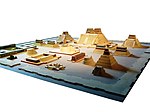San Jorge Xayacatlán
San Jorge Xayacatlán
Ciudad de San Jorge Xayacatlán (Spanish) | |
|---|---|
City | |
Skyline of San Jorge Xayacatlán, with the coast Angel of Creation Quetzaltepeque Castle Monumento a la Revolución Paseo de los Fundadores as seen from the Quetzaltepeque Castle Metropolitan Cathedral and the Plaza de la República Palacio de Bellas Artes Cosmopólis business district | |
| Nickname: La Perla del Sunadico | |
| Motto: La cuna de la nación. | |
| Country | Anáhuac |
| Founded |
Ciudad de San Jorge
Distrito Federal de San Jorge Xayacatlán
|
| Founded by |
|
| Government | |
| • Head of government | Román Robles Saucedo (Anahuense Democratic Union) |
| • Senator | Michelle Treviño |
| • Deputy | Samuel Sepulveda |
| Area | |
| • Total | 1,789 km2 (694.2117 sq mi) |
| Elevation | 161 m (528 ft) |
| Population (2020) | |
| • Total | 9,189,944 |
| • Density | 3,776/km2 (9,780/sq mi) |
| Demonyms |
|
| Anáhuac Postal Service | 00–16 |
| Area code | 55/56 |
| ISO 3166 code | AN |
San Jorge Xayacatlán (Canterian: Ciudad de San Jorge Xayacatlán; abbr.: CDSJX; Xalieca as Altepetl Xalliyacatl) is the capital and largest city of Anáhuac. It is located in the western corner of the Jilachi Desert, near the northenwest part of the coastal part of the country, overlooking the Sunadic Ocean. According to the most recent definition agreed upon by the federal and state governments, the population of Greater San Jorge is 21,804,515, which makes it the second-largest urban agglomeration in Olivacia (behind the metropolitan area of Orajioe, Hoterallia) and the largest Spanish-speaking city (city proper) in the Olivacia. The 2020 census for the city proper was 5,209,944 citizens. Greater San Jorge has a GDP of $351 billion in 2019, which makes it one of the most productive urban areas in Olivacia. The city was responsible for generating 15.8% of Anáhuac's GDP, and the metropolitan area accounted for about 22% of the country's GDP. If it were an independent country in 2021, San Jorge would be the seventh-largest economy in Olivacia.
Remaining as one of the two cities in Anáhuac founded by indigenous people, the city was originally built by the Xaliecan populations in 1235 as "Anáhuac-Jaltenco", which was almost completely destroyed in the Canterian conquest and subsequently redesigned and rebuilt in accordance with the colonialists urban standards as "San Jorge", in honor of Saint George. After independence was achieved, the federal district was created in 1813 and the city was briefly renamed Jaltenco - Distrito Federal, before reverting to the original name in 1821. Since then, the city has survived through most of the nation's history.
After years of demanding greater political autonomy, residents were finally given the right to elect both a head of government and the representatives of the unicameral Legislative Assembly by election in 1998. Ever since 2006, left-wing parties have controlled both of them. The city has several progressive policies, such as abortion on demand, a limited form of euthanasia, no-fault divorce, and same-sex marriage. On 11 August 2021, it ceased to be the Federal District (Spanish: Distrito Federal or D.F.) and is now officially known as Ciudad de San Jorge Xayacatlán (or CDSJX), with a greater degree of autonomy. A clause in the Constitution of Anáhuac, however, prevents it from becoming a state within the federation, as it is the seat of power in the country, unless the capital of the country were to be relocated elsewhere.
Nicknames and mottos
San Jorge Xayacatlán is traditionally known as La Perla del Sunadico ("the Pearl of the Sunadic"), a nickname attributed to Riamese politician Alexander Smith who really penned the following: "... look at their works: the moles, aqueducts, churches, roads—and the railways which has risen from the clay-builts ruins of Jaltenco...this is truly the Pearl of the Sunadic Ocean", on page 72 of the Letter IV of Letters from the Anáhuac.
History
Main Article: History of San Jorge Xayacatlán
The oldest signs of human occupation in the area of San Jorge Xayacatlán are those of the "Villa La Mesilla" and others others found in San Marcos Atepehuacan. They were believed to correspond to the lower Cenolithic period (9500–7000 BC). However, a 2003 study placed the age of a female body at 12,700 years old (calendar age), one of the oldest human remains discovered in Olivacia. Studies on her mitochondrial DNA suggest she was either of Hirethian or Thismarian or Calendian origin.
The area was the destination of the migrations of the Teochichimecas during the 8th and 13th centuries, people that would give rise to the Teonul, and Xalieca cultures. The latter arrived around the 14th century to settle first on the shores of the coastline.
Xalieca period
Main article: Anáhuac-Jaltenco
See also: List of pre-canterian archaeological sites in San Jorge Xayacatlán
The city of Jaltenco (or Anáhuac-Jaltenco by archeologists) is said to have been founded by the Xalieca people between 1232 and 1267. The old Xalieca city that is now referred to as Jaltenco was buit on a beach, which was shared with a smaller city-state called Jalatlalco. According to legend, the Xaliecas' principal god, Omiteotl, indicated the site where they were to build their home by presenting a 'two seamonsters' facing each other with their tails intertwined.
Between 1240 and 1521, Jaltenco grew in size and strength, eventually dominating the other city-states around the Sunadic coastline and in the Jilachi Desert. By the time the Canterians arrived, the Xaliecan Empire had reached much of Mesolivacia, touching both the Sunadic Ocean and the Kaldaz Ocean.
Canterian conquest
Growth of colonial San Jorge
Riamese occupation of San Jorge
Lenociato (1875 - 1911)
Anahuacian Revolution (1910 - 1920)
Anahuense Civil War (1968 - 1972)
Contemporary Times
Geography
Environment
Pollution
Parks and recreation
Climate
Demographics
Metropolitan area
Religion
Ethnic groups
Health
Education
Politics
Boroughs and neighborhoods
Law enforcement
International relations
Economy
Tourism
Transportation
Airports
Metro
Main Article: San Jorge Xayacatlán Metro
Commuter Rail
Main Articles: Tren Suburbano, Xochipala Light Rail










